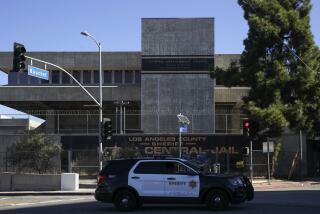Court Limits Suits Against Prison Guards
- Share via
WASHINGTON — The Supreme Court, sharply limiting the ability of inmates to sue guards for injuries in a prison riot, ruled Tuesday that the use of deadly force to quell a disturbance is unconstitutional only if it is done “sadistically or maliciously.”
In a 5-4 decision, the justices overturned a ruling by the U.S. 9th Circuit Court of Appeals in San Francisco and threw out a civil rights damage suit brought against Oregon prison authorities by an inmate who, when in a peace-making role, was shot in the leg by a guard trying to restore order.
The court continued its trend in recent years of giving prison officials broad discretion to preserve order and discipline, restricting inmate rights where necessary. Under the ruling, authorities will be able to put down disorders with much less risk of being sued for resulting injuries to inmates.
Opinion by O’Connor
“The infliction of pain in the course of a prison security measure does not amount to cruel and unusual punishment simply because it may appear in retrospect that the degree of force authorized or applied . . . was unreasonable and hence unnecessary in the strict sense,” Justice Sandra Day O’Connor wrote for the majority.
As long as authorities act in “good faith” to end a disturbance that poses “significant risks” to safety--rather than acting “maliciously or sadistically for the very purpose of causing harm”--there is no violation of the Eighth Amendment, O’Connor said.
In dissent, Justice Thurgood Marshall, joined by Justices William J. Brennan Jr., Harry A. Blackmun and John Paul Stevens, said that the Oregon inmate should have had a chance to take his case to the jury.
The court’s new standard for determining when rights are violated in such cases is “especially onerous,” Marshall wrote. And the question of whether a disturbance actually posed dangers sufficient to warrant lethal force should be left to jurors, he said.
Prison Riot in Oregon
The case (Whitley vs. Albers, 84-1077) stemmed from a riot at the Oregon State Penitentiary in June, 1980, in which a guard was taken hostage. An inmate, Gerald Albers, left his cell to help move elderly inmates to a safer place. But, Albers was shot as he ran back to his cell when armed guards approached. Other inmates were injured, but no one was killed. The hostage was released unharmed.
Albers, who suffered an injury that required him to walk with a leg brace, brought suit against several officers, including Harol Whitley, who had authorized the guards’ assault after officials decided that the use of tear gas was not feasible. Whitley shouted: “Let’s go! Let’s go! Shoot the bastards!” just before the assault began, Albers said.
A U.S. district judge invalidated the suit but the appeals court reinstated it, marking the first time that a federal court had allowed a legal action alleging cruel and unusual punishment arising from a prison disturbance.
Handling of Union Fees
In another decision (Chicago Teachers Union vs. Hudson, 84-1503), the court issued guidelines for the way public employee unions must handle fees they receive from non-members in lieu of dues under agency shop contracts.
The court previously has ruled that, although non-members may be required to pay such fees to support union collective bargaining, they cannot be forced to pay for union political activity.
In a unanimous decision, the justices said Tuesday that unions must offer an adequate explanation of how the fees are to be spent, provide a “reasonably prompt” opportunity to challenge the amount of the fee before an impartial decision-maker and place in escrow amounts reasonably in dispute while challenges are pending.
More to Read
Sign up for Essential California
The most important California stories and recommendations in your inbox every morning.
You may occasionally receive promotional content from the Los Angeles Times.













